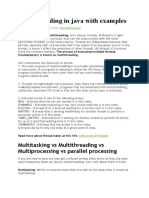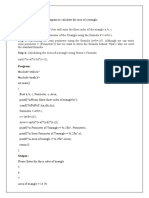0% found this document useful (0 votes)
16 views16 pagesMultithreading
The document provides an overview of multithreading in Java, explaining the concepts of processes and threads, their life cycles, and how to create and manage threads. It discusses thread synchronization to prevent data inconsistency when multiple threads access shared resources and introduces methods for creating threads, such as extending the Thread class or implementing the Runnable interface. Additionally, it covers thread priorities, joining threads, and the importance of synchronization using the synchronized keyword to ensure safe access to shared resources.
Uploaded by
s54479391Copyright
© © All Rights Reserved
We take content rights seriously. If you suspect this is your content, claim it here.
Available Formats
Download as DOCX, PDF, TXT or read online on Scribd
0% found this document useful (0 votes)
16 views16 pagesMultithreading
The document provides an overview of multithreading in Java, explaining the concepts of processes and threads, their life cycles, and how to create and manage threads. It discusses thread synchronization to prevent data inconsistency when multiple threads access shared resources and introduces methods for creating threads, such as extending the Thread class or implementing the Runnable interface. Additionally, it covers thread priorities, joining threads, and the importance of synchronization using the synchronized keyword to ensure safe access to shared resources.
Uploaded by
s54479391Copyright
© © All Rights Reserved
We take content rights seriously. If you suspect this is your content, claim it here.
Available Formats
Download as DOCX, PDF, TXT or read online on Scribd
/ 16





















































































